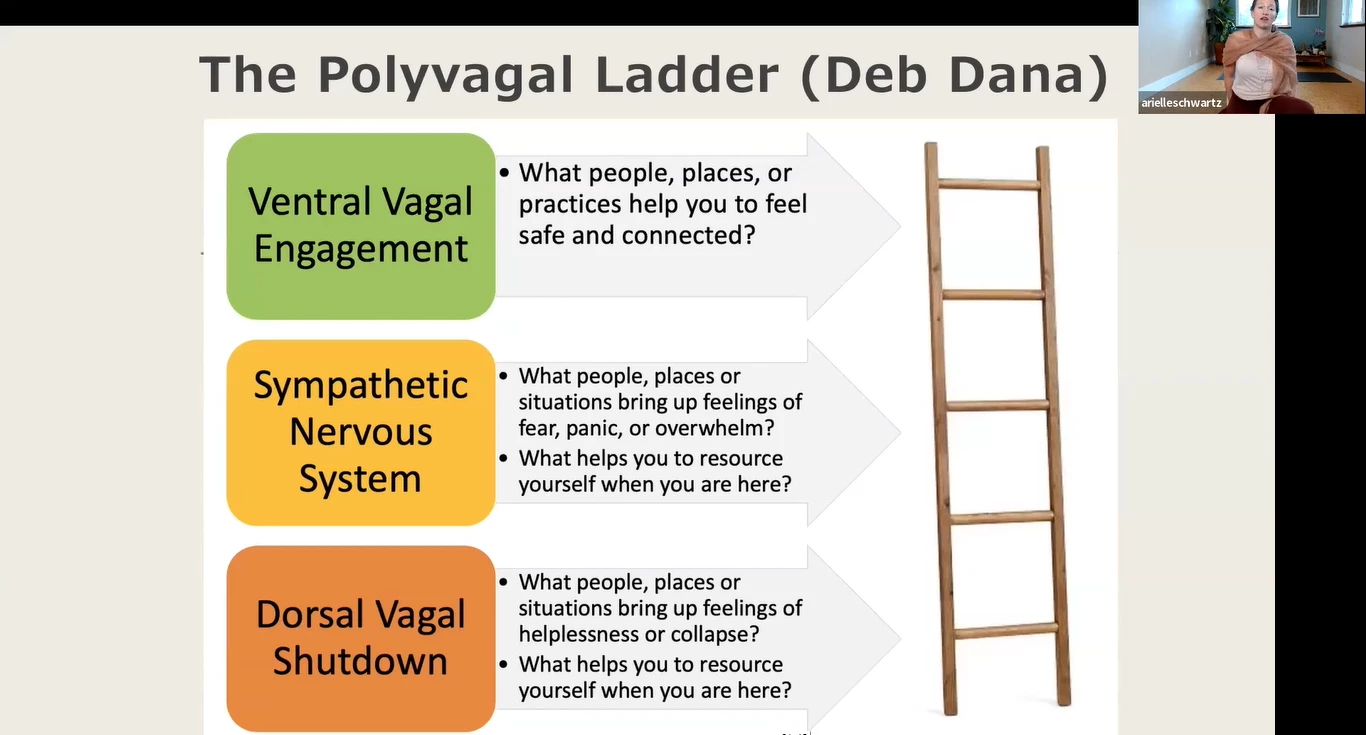How Healthy Is Your Nervous System: Polyvagal Theory Made Simple

Article At A Glance
Looking for ways to help reduce anxiety, stress, and negative reactions to life’s adversities? Ways to improve your nervous system health?
Of course! We all go through periods in life where we wish we had a magic wand to ease the burden of stress and trauma, yes?
Thanks to recent advances in understanding the long-term effects of stress and trauma, we now have some powerful tools at our disposal for reversing the effects of stress and adversity.
In the video below, renowned author Dr. Arielle Schwartz shares one simple tool for first determining where we fall on a scale of stress and trauma and, secondly, how to deal with the lingering effects of stress and trauma on our nervous system: The Polyvagal Ladder.
The Polyvagal Ladder: Keys to Finding Your Sweet Spot
Drawing on the work of Dr. Stephen Porges, the Polyvagal Ladder gives us a tool to determine where we fall on a scale of vagal functioning.
Poly means many, and polyvagal theory describes three modes of nervous system functioning and how affected we are by trauma, stress, and adversity.
Do you fall in the Green zone, the Orange zone, or the Red zone?
Green is the Go-Ahead Zone – This is the rest-and-digest, relaxed mode of functioning. (For you Yoga Nerds: this is also referred to as the Ventral Vagal Engagement). This is our happy, restful, smell-the-roses zone.
Orange Is the Oh-Oh! Zone. This is that frantic, fight-or-flight, hyper mode of functioning we all go into when our stress load gets to be too much. Our mind and body go into sympathetic overdrive, and we just can’t seem to relax and let go.
Red Is the High-Risk, Red-Alert Zone. This is the Freeze-or-Faint zone, where mind and body go into overload, and we begin to shut down physically, mentally, and emotionally. It’s a state of shut-down and dissociation; we may feel brain fog, chronic fatigue, and an inability to connect with the world around us. The red zone is also known as the Dorsal Vagal Shutdown, and it is the system’s ultimate response to extreme trauma.
The good news? Once we are familiar with the three zones of nervous system functioning, we can use techniques to move from the Orange Zone to the Green Zone or the Red Zone toward the Green Zone.
This is what Yoga for Trauma Release is all about. As it turns out, the ancient yogic techniques contain numerous ways to settle the mind and body and induce greater ease and calm in the mind and body.
Moving Up the Polyvagal Ladder: Yoga for Trauma Release
How do we move from the Orange or Red Zone to the Green Zone?
In the video below, Dr. Arielle Schwartz talks about the techniques we can use to alter the state of our nervous system and move towards a more calm and positive way of functioning. Click below to watch the full video!
Yoga for Trauma Recovery: A Yoga Practice for Enhancing Vagal Tone
Wonder about specific yogic practices for engaging the vagus nerve and inducing a more healthy, green zone mode of functioning?
Watch the video below, where Dr. Arielle shares a simple warmup practice to stimulate vagus nerve functioning.
Also, read...
Yoga for Stress Relief: 2 Practices for Deep Relaxation
Feb 28 – Beth Gibbs, MA
Nourish Your Winter Body with a Restorative Yoga Practice
Feb 03 – Jillian Pransky
3 Steps to Practicing Active Happiness
Jan 15 – Sandy Blaine
Related courses
Keys to Finding Inner Strength: A Yogic Wisdom Path to Developing Greater Resilience
With Arielle Schwartz
Somatic Yoga for Fascial Unwinding
With James Knight

Dr. Arielle Schwartz is a psychologist, author, and internationally sought-out yoga teacher, who is known as a leading expert on polyvagal theory. Dr. Arielle is known for her great practical approach to integrating modern polyvagal theory with ancient yogic practices to connect us with our own inner resources for dealing with stress, trauma, and adversity.

Eva Norlyk Smith, Ph.D., is the founder and President of YogaUOnline. She is a lead trainer in YogaUOnline’s Yoga Wellness Educator program, an RYT-300 Yoga Alliance-approved training that focuses on giving teachers the skills they need to offer wellness courses and work with older beginners
Recent articles
Empowered Aging: An Interview with Yoga Teacher Ellen Saltonstall
Apr 17 – Sarah Bell ERYT-500, YACEP
4 Yoga Poses to Strengthen the 4 Muscles of the Rotator Cuff
Apr 15 – Leah Sugerman, E-RYT 500, YACEP
Categories
Upcoming courses
Keys to Finding Inner Strength: A Yogic Wisdom Path to Developing Greater Resilience
With Arielle Schwartz
FREE DOWNLOAD!
Recent articles
Almost there...
Sorry, we couldn't find anything...
Yoga Practice Tips
Dhanurasana (Bow Pose) with a Yoga Strap Bowstring
Years ago, I heard Judith Hanson Lasater pose this question: “Who should practice backbends?”…
Apr 19 –
Yoga and Healthy Aging
Empowered Aging: An Interview with Yoga Teacher Ellen Saltonstall
YogaUOnline: We are delighted today to be here with Ellen Saltonstall to discuss her…
Apr 17 – Sarah Bell ERYT-500, YACEP
Anatomy
4 Yoga Poses to Strengthen the 4 Muscles of the Rotator Cuff
The shoulder’s rotator cuff is a group of four separate muscles that work together…
Apr 15 – Leah Sugerman, E-RYT 500, YACEP


